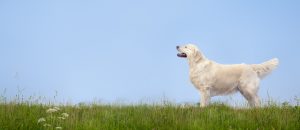4) Exercise lots

The energy balance equation has calories in (food) on one side and calories out on the other. Surprisingly, the majority of energy used up by a dog each day goes towards just maintaining the body and keeping alive, and keeping warm. Exercise is a relatively small fraction of the whole. However, exercise is the bit we can change and there is no doubt that dogs who get loads of exercise can eat more without piling on the pounds.
How much is enough? The PDSA has a useful guide you can find by following this link. Do take time to read it once you are done here. Many dogs just don’t get enough time outside. That risks obesity in any dog, let alone one whose genes make them predisposed.
Working breeds like Labradors thrive on over two hours of exercise a day, much more than many pet dogs get. We don’t want to use this website to ‘preach’ but please do think hard about the amount and quality of your dogs’ exercise. If your dog gets less than the recommendation, or acts like they would like to go for longer walks, ask yourself whether you could get them out more.
- Can you improve the quality of daily walks? Ball launchers or frisbees can increase the mileage your dog does, even if you stand still to throw. Would your dog follow you on a bike?
- Does your dog spend most of the time on a lead? Why? Dogs walked on leads cover much less mileage than when allowed to explore. If you are worried about recall, consider some dog training classes. If you are worried your dog will scavenge, consider using a basket muzzle so they can explore safely without being able to eat.
- Could your dog spend more of the day outside? Even just pottering around investigating smells is exercise and better than lounging inside on the sofa. Consider a kennel or dog flap so your dog can use the garden if you are away from the house.
- Can you get your dog more active at home? Puzzle feeders (see previous page) and toys can be really good at getting dogs moving in the house.
Remember that there are some good reasons for limiting exercise: puppy joints can be damaged by sustained running, and breathing problems, illness or arthritis may mean other dogs can’t exercise vigorously. Speak to your vet or vet nurse if you are concerned.
Of course, lots of exercise has the additional benefit of distracting dogs from food. They might scavenge on walks, but you can usually deal with that by reducing the food they get at home. It is our experience that of the dogs with the POMC mutation which are slim, they all get masses of exercise – try it if your dog is affected too!
So, these are our 4 Strategies for Slender Dogs
- Monitor your dog – intervene early
- Feed the right amount
- Restrict food kindly – to minimise hunger
- Exercise lots
If your dog is already overweight, please do read these pages, but also speak to your veterinary practice who will help you make a tailored plan for your pet. There will be more advice on this website soon.


